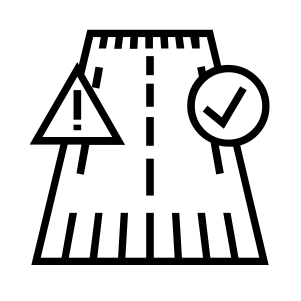
Braking Action Computation Function (BACF)
Manage Risks (Avionics)
Improve runway condition awareness
Use the aircraft as a sensor to measure and report the braking action the aircraft experienced during landing.

Manage Risks (Avionics)
Use the aircraft as a sensor to measure and report the braking action the aircraft experienced during landing.
AIRBUS has developed a new AIRBUS aircraft function which uses on board data to identify the braking action the aircraft experienced during landing.
The implementation of this function on AIRBUS aircraft, called the “Braking Action Computation Function’ (BACF)”, responds to recommendations issued by several safety bodies, such as the NTSB, for “an operationally feasible airplane-based braking ability / runway surface condition measurement and communication system”.
The fundamental principle of the function is, post landing, to use the data measured by the aircraft during its landing roll to identify the braking action level. By using the aircraft performance model, it is possible to differentiate the parts of deceleration coming from aerodynamics, thrust reverse, and wheel-braking.
By comparing the actual wheel braking performance to models of wheel-braking performance for standardized “reference” runway conditions, the software can identify the braking action(s) the aircraft experienced.
As well as being able to detect several different braking actions along the runway, each braking action zone is GPS tagged to identify exactly where on the runway they occurred.
After landing, the flight crew may directly consult the braking action report on a dedicated MCDU page. The flight crew may use this information, along with their own observations as part of their Pilot Report (PIREP) of Braking Action back to Air Traffic Services.
ACARS data sent to the ground systems with the results, gives digital data about the braking actions experienced across their fleet of aircraft, throughout their route network.
Initial availability of the BACF is for the A320 and A330 aircraft families. The BACF software consists of an ATSU AOC application and is available as an AIRBUS Standard Service Bulletin – Free-Of-Charge.
Do you want to install BACF on your aircraft? Just create a ticket, here
1
2
3
Already 1,600+ aircraft committed to be equipped with BACF


| Cookie | Duration | Description |
|---|---|---|
| cookielawinfo-checkbox-analytics | 11 months | This cookie is set by GDPR Cookie Consent plugin. The cookie is used to store the user consent for the cookies in the category "Analytics". |
| cookielawinfo-checkbox-functional | 11 months | The cookie is set by GDPR cookie consent to record the user consent for the cookies in the category "Functional". |
| cookielawinfo-checkbox-necessary | 11 months | This cookie is set by GDPR Cookie Consent plugin. The cookies is used to store the user consent for the cookies in the category "Necessary". |
| cookielawinfo-checkbox-others | 11 months | This cookie is set by GDPR Cookie Consent plugin. The cookie is used to store the user consent for the cookies in the category "Other. |
| cookielawinfo-checkbox-performance | 11 months | This cookie is set by GDPR Cookie Consent plugin. The cookie is used to store the user consent for the cookies in the category "Performance". |
| viewed_cookie_policy | 11 months | The cookie is set by the GDPR Cookie Consent plugin and is used to store whether or not user has consented to the use of cookies. It does not store any personal data. |